The Influence of Media on Health in Australia: An Analysis
VerifiedAdded on 2021/04/16
|11
|3370
|28
Essay
AI Summary
This essay critically analyzes the role and power of the Australian media and its influence on culturally safe health care in multicultural Australian society. It explores how media serves as a powerful tool in shaping health perceptions, disseminating health information, and potentially influencing health outcomes, both positively and negatively. The essay references studies highlighting the pervasive influence of media, including television, the internet, and social media, on Australians' access to and consumption of health-related information. It examines the potential for media to be used to advance or control health-related issues, including examples of disease mongering and the impact of food advertising on children. The essay also discusses the importance of media regulation and provides examples of how the Australian government has attempted to regulate media to protect public health, concluding with a call for increased regulation to ensure the reliability and trustworthiness of health information presented through media outlets. The essay also highlights positive media items, such as the ABC television program "Ask the Doctor" as a case study.
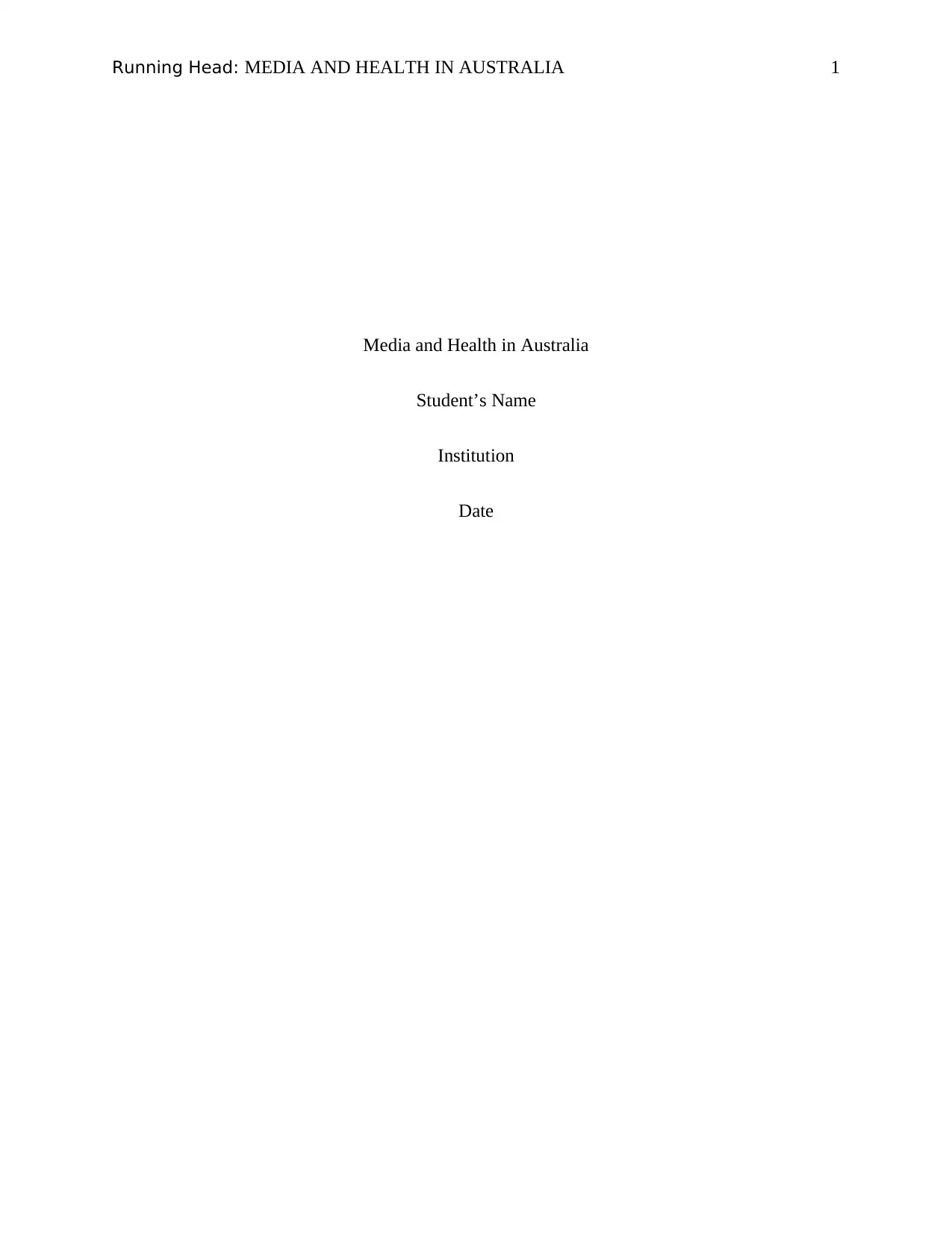
Running Head: MEDIA AND HEALTH IN AUSTRALIA 1
Media and Health in Australia
Student’s Name
Institution
Date
Media and Health in Australia
Student’s Name
Institution
Date
Paraphrase This Document
Need a fresh take? Get an instant paraphrase of this document with our AI Paraphraser
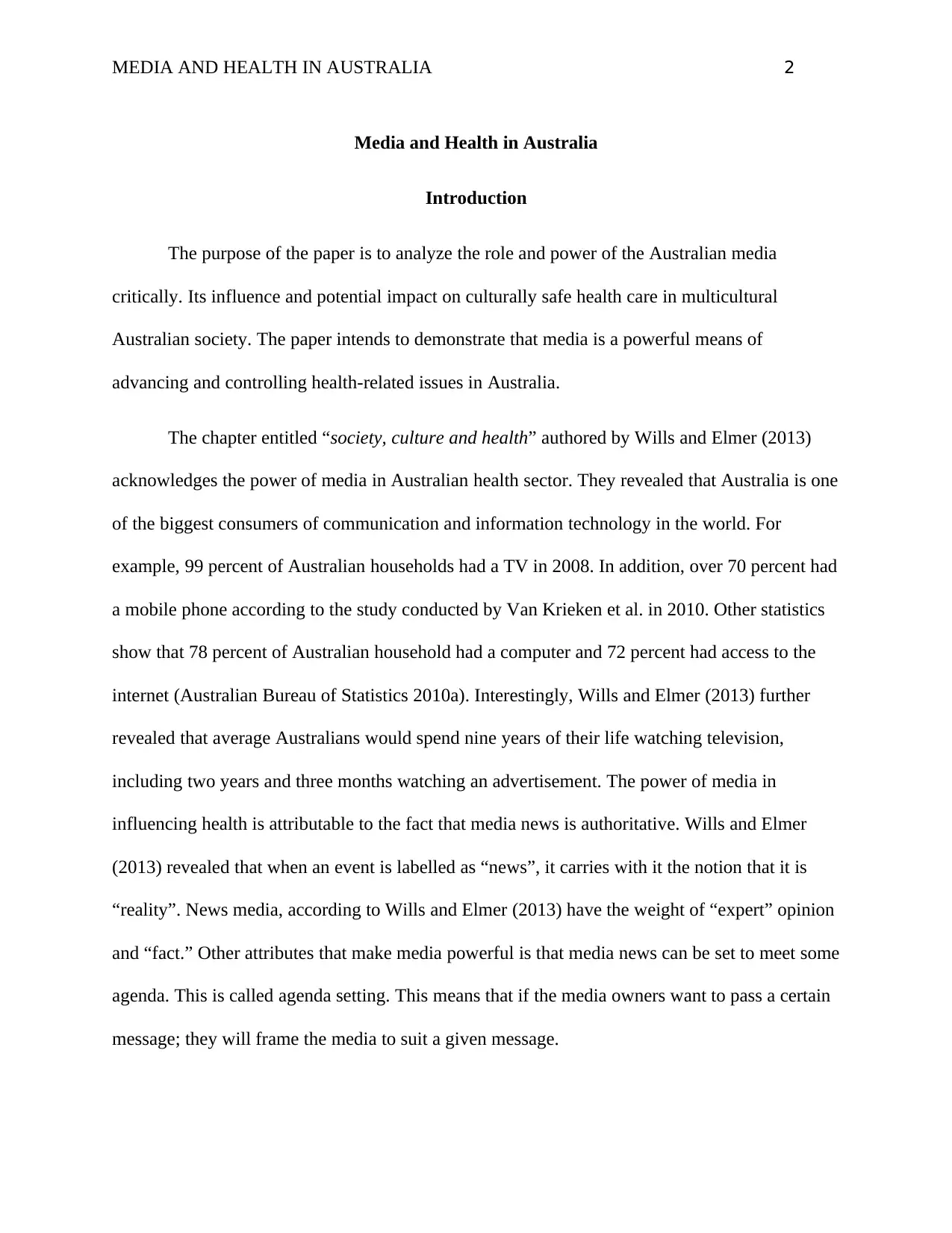
MEDIA AND HEALTH IN AUSTRALIA 2
Media and Health in Australia
Introduction
The purpose of the paper is to analyze the role and power of the Australian media
critically. Its influence and potential impact on culturally safe health care in multicultural
Australian society. The paper intends to demonstrate that media is a powerful means of
advancing and controlling health-related issues in Australia.
The chapter entitled “society, culture and health” authored by Wills and Elmer (2013)
acknowledges the power of media in Australian health sector. They revealed that Australia is one
of the biggest consumers of communication and information technology in the world. For
example, 99 percent of Australian households had a TV in 2008. In addition, over 70 percent had
a mobile phone according to the study conducted by Van Krieken et al. in 2010. Other statistics
show that 78 percent of Australian household had a computer and 72 percent had access to the
internet (Australian Bureau of Statistics 2010a). Interestingly, Wills and Elmer (2013) further
revealed that average Australians would spend nine years of their life watching television,
including two years and three months watching an advertisement. The power of media in
influencing health is attributable to the fact that media news is authoritative. Wills and Elmer
(2013) revealed that when an event is labelled as “news”, it carries with it the notion that it is
“reality”. News media, according to Wills and Elmer (2013) have the weight of “expert” opinion
and “fact.” Other attributes that make media powerful is that media news can be set to meet some
agenda. This is called agenda setting. This means that if the media owners want to pass a certain
message; they will frame the media to suit a given message.
Media and Health in Australia
Introduction
The purpose of the paper is to analyze the role and power of the Australian media
critically. Its influence and potential impact on culturally safe health care in multicultural
Australian society. The paper intends to demonstrate that media is a powerful means of
advancing and controlling health-related issues in Australia.
The chapter entitled “society, culture and health” authored by Wills and Elmer (2013)
acknowledges the power of media in Australian health sector. They revealed that Australia is one
of the biggest consumers of communication and information technology in the world. For
example, 99 percent of Australian households had a TV in 2008. In addition, over 70 percent had
a mobile phone according to the study conducted by Van Krieken et al. in 2010. Other statistics
show that 78 percent of Australian household had a computer and 72 percent had access to the
internet (Australian Bureau of Statistics 2010a). Interestingly, Wills and Elmer (2013) further
revealed that average Australians would spend nine years of their life watching television,
including two years and three months watching an advertisement. The power of media in
influencing health is attributable to the fact that media news is authoritative. Wills and Elmer
(2013) revealed that when an event is labelled as “news”, it carries with it the notion that it is
“reality”. News media, according to Wills and Elmer (2013) have the weight of “expert” opinion
and “fact.” Other attributes that make media powerful is that media news can be set to meet some
agenda. This is called agenda setting. This means that if the media owners want to pass a certain
message; they will frame the media to suit a given message.
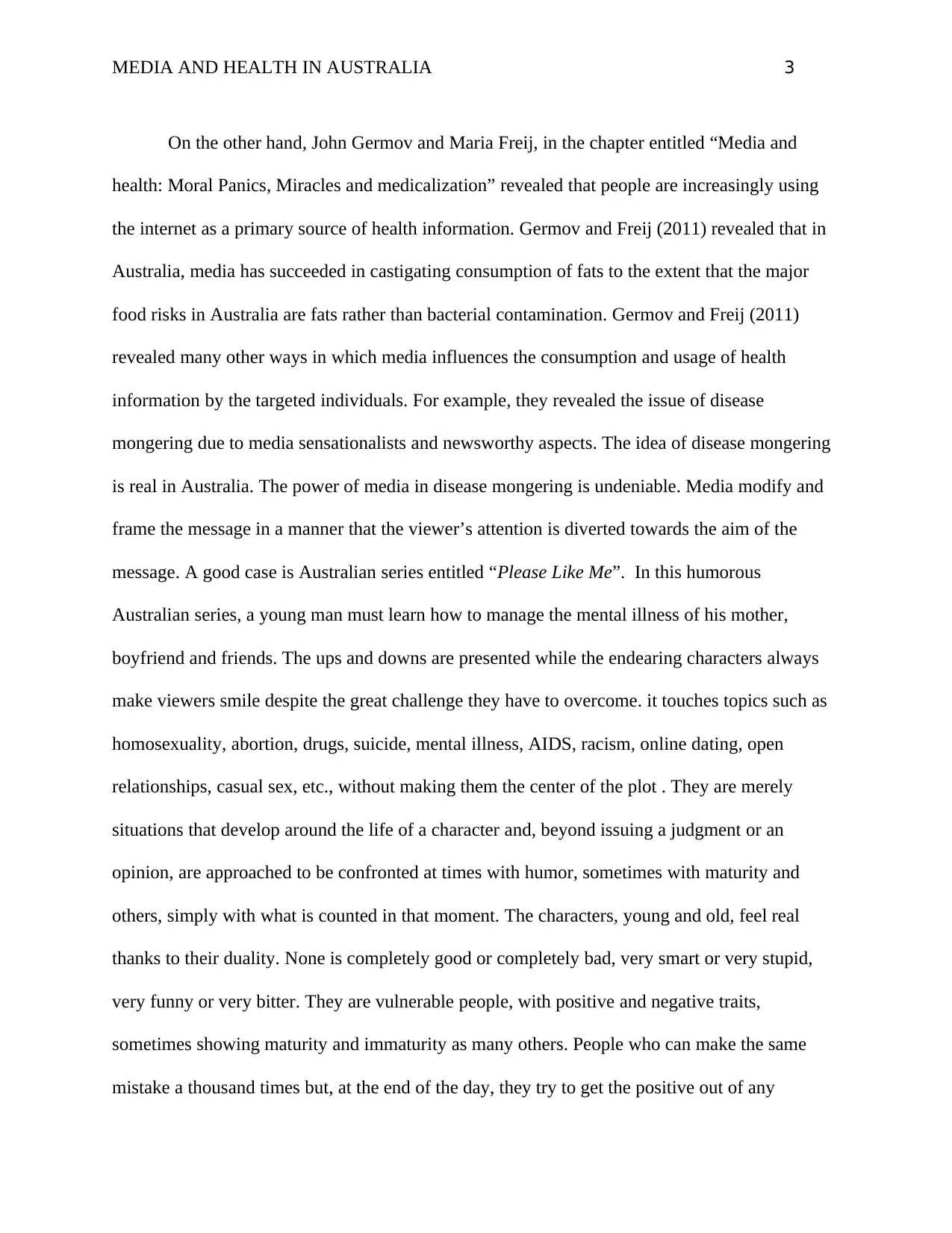
MEDIA AND HEALTH IN AUSTRALIA 3
On the other hand, John Germov and Maria Freij, in the chapter entitled “Media and
health: Moral Panics, Miracles and medicalization” revealed that people are increasingly using
the internet as a primary source of health information. Germov and Freij (2011) revealed that in
Australia, media has succeeded in castigating consumption of fats to the extent that the major
food risks in Australia are fats rather than bacterial contamination. Germov and Freij (2011)
revealed many other ways in which media influences the consumption and usage of health
information by the targeted individuals. For example, they revealed the issue of disease
mongering due to media sensationalists and newsworthy aspects. The idea of disease mongering
is real in Australia. The power of media in disease mongering is undeniable. Media modify and
frame the message in a manner that the viewer’s attention is diverted towards the aim of the
message. A good case is Australian series entitled “Please Like Me”. In this humorous
Australian series, a young man must learn how to manage the mental illness of his mother,
boyfriend and friends. The ups and downs are presented while the endearing characters always
make viewers smile despite the great challenge they have to overcome. it touches topics such as
homosexuality, abortion, drugs, suicide, mental illness, AIDS, racism, online dating, open
relationships, casual sex, etc., without making them the center of the plot . They are merely
situations that develop around the life of a character and, beyond issuing a judgment or an
opinion, are approached to be confronted at times with humor, sometimes with maturity and
others, simply with what is counted in that moment. The characters, young and old, feel real
thanks to their duality. None is completely good or completely bad, very smart or very stupid,
very funny or very bitter. They are vulnerable people, with positive and negative traits,
sometimes showing maturity and immaturity as many others. People who can make the same
mistake a thousand times but, at the end of the day, they try to get the positive out of any
On the other hand, John Germov and Maria Freij, in the chapter entitled “Media and
health: Moral Panics, Miracles and medicalization” revealed that people are increasingly using
the internet as a primary source of health information. Germov and Freij (2011) revealed that in
Australia, media has succeeded in castigating consumption of fats to the extent that the major
food risks in Australia are fats rather than bacterial contamination. Germov and Freij (2011)
revealed many other ways in which media influences the consumption and usage of health
information by the targeted individuals. For example, they revealed the issue of disease
mongering due to media sensationalists and newsworthy aspects. The idea of disease mongering
is real in Australia. The power of media in disease mongering is undeniable. Media modify and
frame the message in a manner that the viewer’s attention is diverted towards the aim of the
message. A good case is Australian series entitled “Please Like Me”. In this humorous
Australian series, a young man must learn how to manage the mental illness of his mother,
boyfriend and friends. The ups and downs are presented while the endearing characters always
make viewers smile despite the great challenge they have to overcome. it touches topics such as
homosexuality, abortion, drugs, suicide, mental illness, AIDS, racism, online dating, open
relationships, casual sex, etc., without making them the center of the plot . They are merely
situations that develop around the life of a character and, beyond issuing a judgment or an
opinion, are approached to be confronted at times with humor, sometimes with maturity and
others, simply with what is counted in that moment. The characters, young and old, feel real
thanks to their duality. None is completely good or completely bad, very smart or very stupid,
very funny or very bitter. They are vulnerable people, with positive and negative traits,
sometimes showing maturity and immaturity as many others. People who can make the same
mistake a thousand times but, at the end of the day, they try to get the positive out of any
⊘ This is a preview!⊘
Do you want full access?
Subscribe today to unlock all pages.

Trusted by 1+ million students worldwide
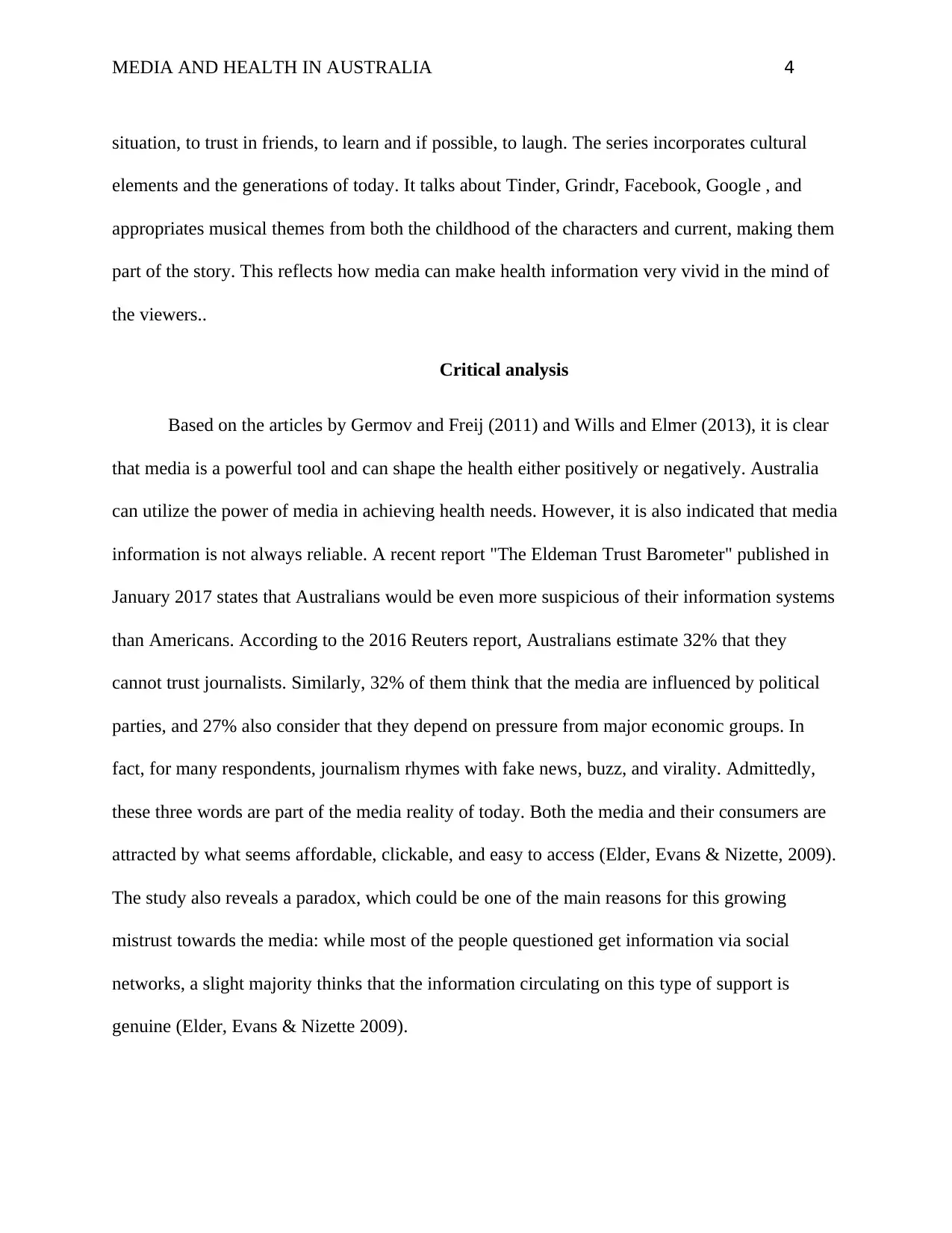
MEDIA AND HEALTH IN AUSTRALIA 4
situation, to trust in friends, to learn and if possible, to laugh. The series incorporates cultural
elements and the generations of today. It talks about Tinder, Grindr, Facebook, Google , and
appropriates musical themes from both the childhood of the characters and current, making them
part of the story. This reflects how media can make health information very vivid in the mind of
the viewers..
Critical analysis
Based on the articles by Germov and Freij (2011) and Wills and Elmer (2013), it is clear
that media is a powerful tool and can shape the health either positively or negatively. Australia
can utilize the power of media in achieving health needs. However, it is also indicated that media
information is not always reliable. A recent report "The Eldeman Trust Barometer" published in
January 2017 states that Australians would be even more suspicious of their information systems
than Americans. According to the 2016 Reuters report, Australians estimate 32% that they
cannot trust journalists. Similarly, 32% of them think that the media are influenced by political
parties, and 27% also consider that they depend on pressure from major economic groups. In
fact, for many respondents, journalism rhymes with fake news, buzz, and virality. Admittedly,
these three words are part of the media reality of today. Both the media and their consumers are
attracted by what seems affordable, clickable, and easy to access (Elder, Evans & Nizette, 2009).
The study also reveals a paradox, which could be one of the main reasons for this growing
mistrust towards the media: while most of the people questioned get information via social
networks, a slight majority thinks that the information circulating on this type of support is
genuine (Elder, Evans & Nizette 2009).
situation, to trust in friends, to learn and if possible, to laugh. The series incorporates cultural
elements and the generations of today. It talks about Tinder, Grindr, Facebook, Google , and
appropriates musical themes from both the childhood of the characters and current, making them
part of the story. This reflects how media can make health information very vivid in the mind of
the viewers..
Critical analysis
Based on the articles by Germov and Freij (2011) and Wills and Elmer (2013), it is clear
that media is a powerful tool and can shape the health either positively or negatively. Australia
can utilize the power of media in achieving health needs. However, it is also indicated that media
information is not always reliable. A recent report "The Eldeman Trust Barometer" published in
January 2017 states that Australians would be even more suspicious of their information systems
than Americans. According to the 2016 Reuters report, Australians estimate 32% that they
cannot trust journalists. Similarly, 32% of them think that the media are influenced by political
parties, and 27% also consider that they depend on pressure from major economic groups. In
fact, for many respondents, journalism rhymes with fake news, buzz, and virality. Admittedly,
these three words are part of the media reality of today. Both the media and their consumers are
attracted by what seems affordable, clickable, and easy to access (Elder, Evans & Nizette, 2009).
The study also reveals a paradox, which could be one of the main reasons for this growing
mistrust towards the media: while most of the people questioned get information via social
networks, a slight majority thinks that the information circulating on this type of support is
genuine (Elder, Evans & Nizette 2009).
Paraphrase This Document
Need a fresh take? Get an instant paraphrase of this document with our AI Paraphraser
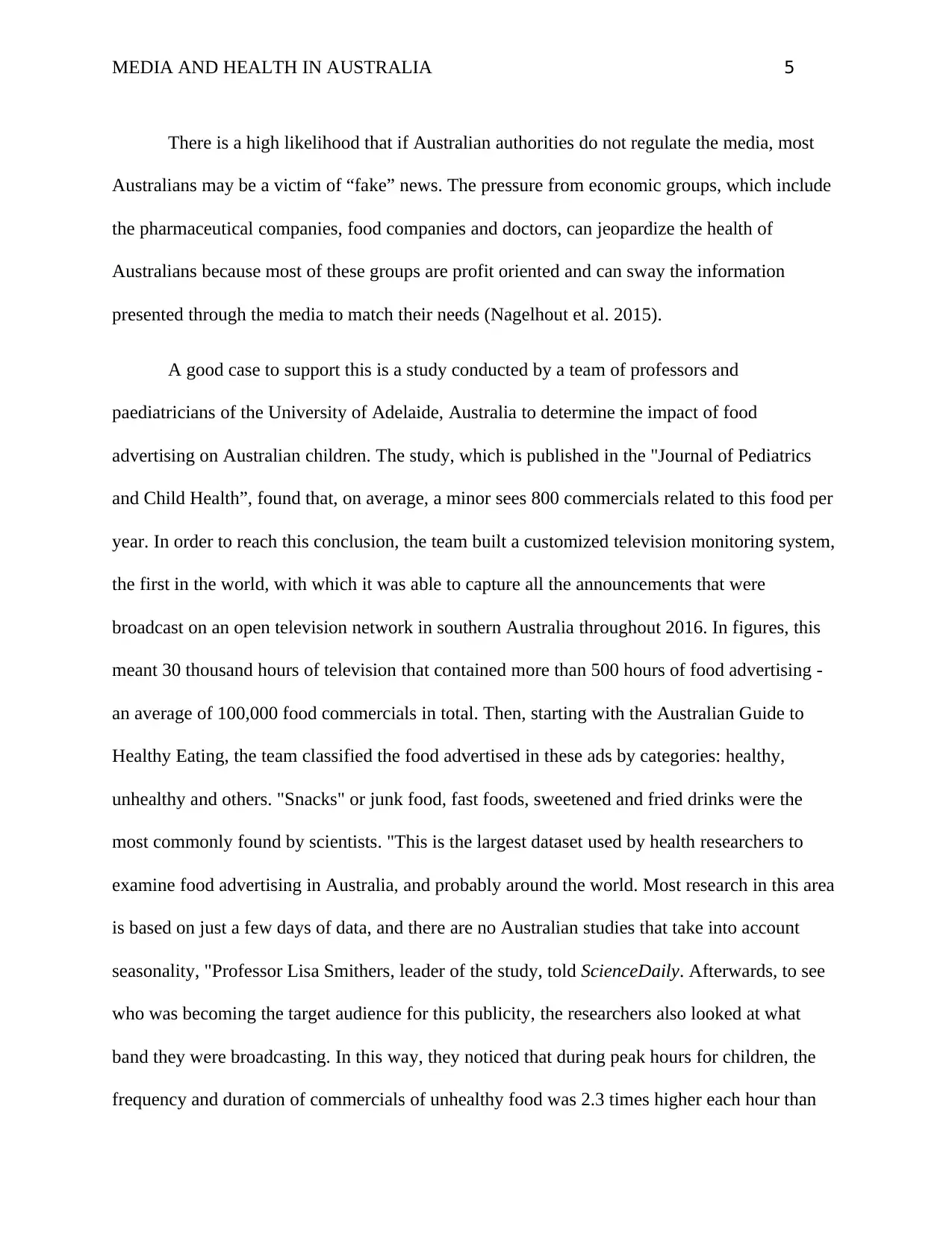
MEDIA AND HEALTH IN AUSTRALIA 5
There is a high likelihood that if Australian authorities do not regulate the media, most
Australians may be a victim of “fake” news. The pressure from economic groups, which include
the pharmaceutical companies, food companies and doctors, can jeopardize the health of
Australians because most of these groups are profit oriented and can sway the information
presented through the media to match their needs (Nagelhout et al. 2015).
A good case to support this is a study conducted by a team of professors and
paediatricians of the University of Adelaide, Australia to determine the impact of food
advertising on Australian children. The study, which is published in the "Journal of Pediatrics
and Child Health”, found that, on average, a minor sees 800 commercials related to this food per
year. In order to reach this conclusion, the team built a customized television monitoring system,
the first in the world, with which it was able to capture all the announcements that were
broadcast on an open television network in southern Australia throughout 2016. In figures, this
meant 30 thousand hours of television that contained more than 500 hours of food advertising -
an average of 100,000 food commercials in total. Then, starting with the Australian Guide to
Healthy Eating, the team classified the food advertised in these ads by categories: healthy,
unhealthy and others. "Snacks" or junk food, fast foods, sweetened and fried drinks were the
most commonly found by scientists. "This is the largest dataset used by health researchers to
examine food advertising in Australia, and probably around the world. Most research in this area
is based on just a few days of data, and there are no Australian studies that take into account
seasonality, "Professor Lisa Smithers, leader of the study, told ScienceDaily. Afterwards, to see
who was becoming the target audience for this publicity, the researchers also looked at what
band they were broadcasting. In this way, they noticed that during peak hours for children, the
frequency and duration of commercials of unhealthy food was 2.3 times higher each hour than
There is a high likelihood that if Australian authorities do not regulate the media, most
Australians may be a victim of “fake” news. The pressure from economic groups, which include
the pharmaceutical companies, food companies and doctors, can jeopardize the health of
Australians because most of these groups are profit oriented and can sway the information
presented through the media to match their needs (Nagelhout et al. 2015).
A good case to support this is a study conducted by a team of professors and
paediatricians of the University of Adelaide, Australia to determine the impact of food
advertising on Australian children. The study, which is published in the "Journal of Pediatrics
and Child Health”, found that, on average, a minor sees 800 commercials related to this food per
year. In order to reach this conclusion, the team built a customized television monitoring system,
the first in the world, with which it was able to capture all the announcements that were
broadcast on an open television network in southern Australia throughout 2016. In figures, this
meant 30 thousand hours of television that contained more than 500 hours of food advertising -
an average of 100,000 food commercials in total. Then, starting with the Australian Guide to
Healthy Eating, the team classified the food advertised in these ads by categories: healthy,
unhealthy and others. "Snacks" or junk food, fast foods, sweetened and fried drinks were the
most commonly found by scientists. "This is the largest dataset used by health researchers to
examine food advertising in Australia, and probably around the world. Most research in this area
is based on just a few days of data, and there are no Australian studies that take into account
seasonality, "Professor Lisa Smithers, leader of the study, told ScienceDaily. Afterwards, to see
who was becoming the target audience for this publicity, the researchers also looked at what
band they were broadcasting. In this way, they noticed that during peak hours for children, the
frequency and duration of commercials of unhealthy food was 2.3 times higher each hour than
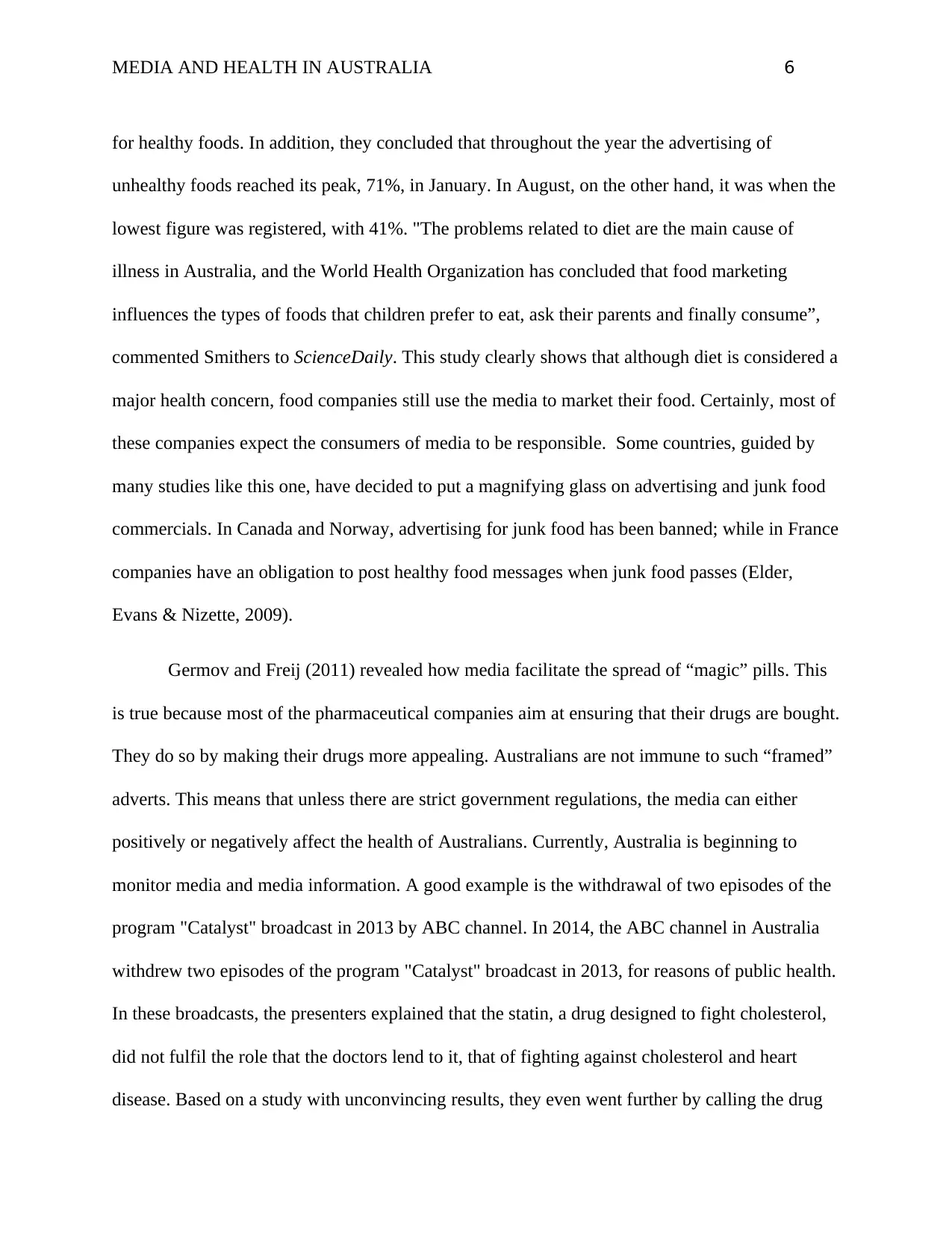
MEDIA AND HEALTH IN AUSTRALIA 6
for healthy foods. In addition, they concluded that throughout the year the advertising of
unhealthy foods reached its peak, 71%, in January. In August, on the other hand, it was when the
lowest figure was registered, with 41%. "The problems related to diet are the main cause of
illness in Australia, and the World Health Organization has concluded that food marketing
influences the types of foods that children prefer to eat, ask their parents and finally consume”,
commented Smithers to ScienceDaily. This study clearly shows that although diet is considered a
major health concern, food companies still use the media to market their food. Certainly, most of
these companies expect the consumers of media to be responsible. Some countries, guided by
many studies like this one, have decided to put a magnifying glass on advertising and junk food
commercials. In Canada and Norway, advertising for junk food has been banned; while in France
companies have an obligation to post healthy food messages when junk food passes (Elder,
Evans & Nizette, 2009).
Germov and Freij (2011) revealed how media facilitate the spread of “magic” pills. This
is true because most of the pharmaceutical companies aim at ensuring that their drugs are bought.
They do so by making their drugs more appealing. Australians are not immune to such “framed”
adverts. This means that unless there are strict government regulations, the media can either
positively or negatively affect the health of Australians. Currently, Australia is beginning to
monitor media and media information. A good example is the withdrawal of two episodes of the
program "Catalyst" broadcast in 2013 by ABC channel. In 2014, the ABC channel in Australia
withdrew two episodes of the program "Catalyst" broadcast in 2013, for reasons of public health.
In these broadcasts, the presenters explained that the statin, a drug designed to fight cholesterol,
did not fulfil the role that the doctors lend to it, that of fighting against cholesterol and heart
disease. Based on a study with unconvincing results, they even went further by calling the drug
for healthy foods. In addition, they concluded that throughout the year the advertising of
unhealthy foods reached its peak, 71%, in January. In August, on the other hand, it was when the
lowest figure was registered, with 41%. "The problems related to diet are the main cause of
illness in Australia, and the World Health Organization has concluded that food marketing
influences the types of foods that children prefer to eat, ask their parents and finally consume”,
commented Smithers to ScienceDaily. This study clearly shows that although diet is considered a
major health concern, food companies still use the media to market their food. Certainly, most of
these companies expect the consumers of media to be responsible. Some countries, guided by
many studies like this one, have decided to put a magnifying glass on advertising and junk food
commercials. In Canada and Norway, advertising for junk food has been banned; while in France
companies have an obligation to post healthy food messages when junk food passes (Elder,
Evans & Nizette, 2009).
Germov and Freij (2011) revealed how media facilitate the spread of “magic” pills. This
is true because most of the pharmaceutical companies aim at ensuring that their drugs are bought.
They do so by making their drugs more appealing. Australians are not immune to such “framed”
adverts. This means that unless there are strict government regulations, the media can either
positively or negatively affect the health of Australians. Currently, Australia is beginning to
monitor media and media information. A good example is the withdrawal of two episodes of the
program "Catalyst" broadcast in 2013 by ABC channel. In 2014, the ABC channel in Australia
withdrew two episodes of the program "Catalyst" broadcast in 2013, for reasons of public health.
In these broadcasts, the presenters explained that the statin, a drug designed to fight cholesterol,
did not fulfil the role that the doctors lend to it, that of fighting against cholesterol and heart
disease. Based on a study with unconvincing results, they even went further by calling the drug
⊘ This is a preview!⊘
Do you want full access?
Subscribe today to unlock all pages.

Trusted by 1+ million students worldwide
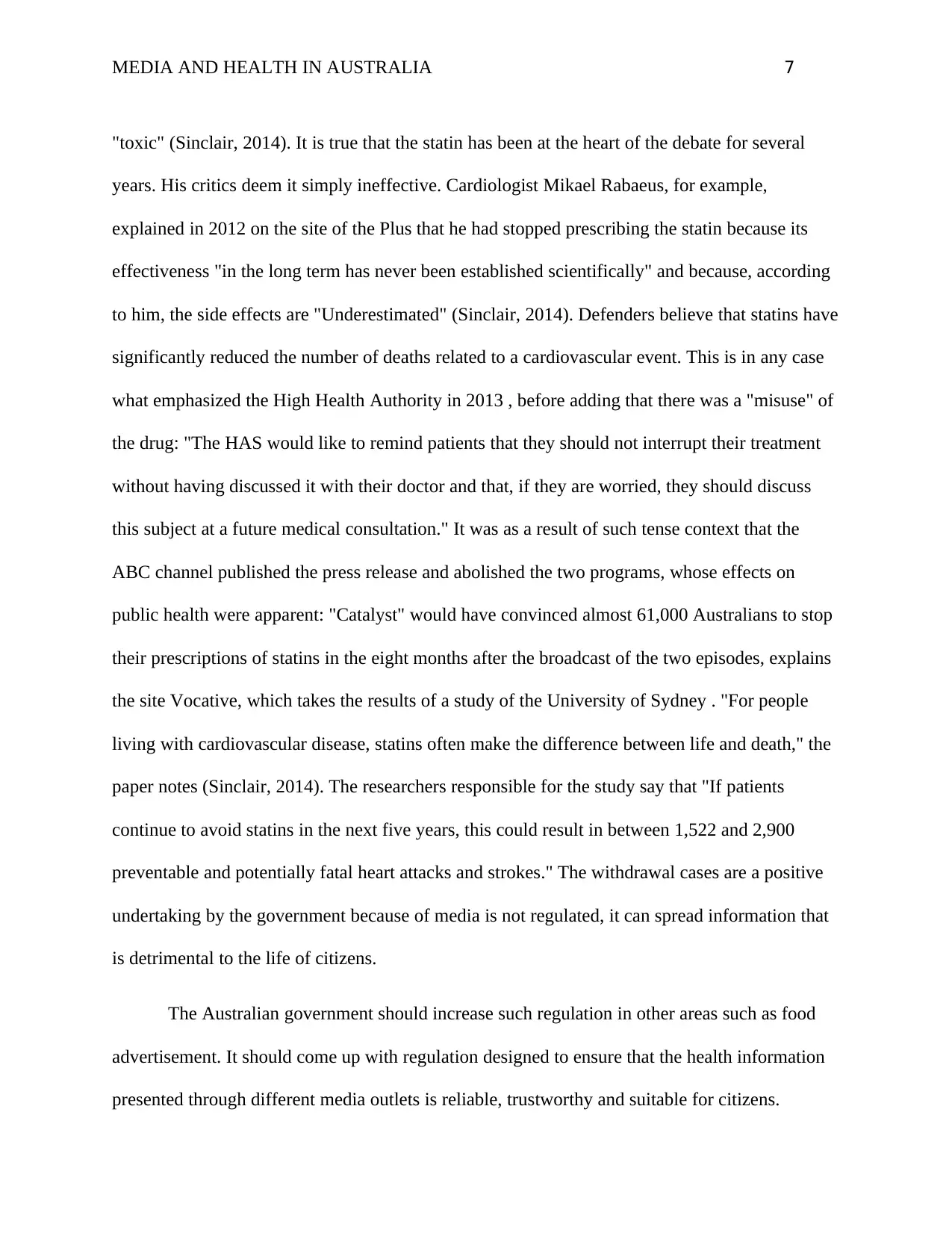
MEDIA AND HEALTH IN AUSTRALIA 7
"toxic" (Sinclair, 2014). It is true that the statin has been at the heart of the debate for several
years. His critics deem it simply ineffective. Cardiologist Mikael Rabaeus, for example,
explained in 2012 on the site of the Plus that he had stopped prescribing the statin because its
effectiveness "in the long term has never been established scientifically" and because, according
to him, the side effects are "Underestimated" (Sinclair, 2014). Defenders believe that statins have
significantly reduced the number of deaths related to a cardiovascular event. This is in any case
what emphasized the High Health Authority in 2013 , before adding that there was a "misuse" of
the drug: "The HAS would like to remind patients that they should not interrupt their treatment
without having discussed it with their doctor and that, if they are worried, they should discuss
this subject at a future medical consultation." It was as a result of such tense context that the
ABC channel published the press release and abolished the two programs, whose effects on
public health were apparent: "Catalyst" would have convinced almost 61,000 Australians to stop
their prescriptions of statins in the eight months after the broadcast of the two episodes, explains
the site Vocative, which takes the results of a study of the University of Sydney . "For people
living with cardiovascular disease, statins often make the difference between life and death," the
paper notes (Sinclair, 2014). The researchers responsible for the study say that "If patients
continue to avoid statins in the next five years, this could result in between 1,522 and 2,900
preventable and potentially fatal heart attacks and strokes." The withdrawal cases are a positive
undertaking by the government because of media is not regulated, it can spread information that
is detrimental to the life of citizens.
The Australian government should increase such regulation in other areas such as food
advertisement. It should come up with regulation designed to ensure that the health information
presented through different media outlets is reliable, trustworthy and suitable for citizens.
"toxic" (Sinclair, 2014). It is true that the statin has been at the heart of the debate for several
years. His critics deem it simply ineffective. Cardiologist Mikael Rabaeus, for example,
explained in 2012 on the site of the Plus that he had stopped prescribing the statin because its
effectiveness "in the long term has never been established scientifically" and because, according
to him, the side effects are "Underestimated" (Sinclair, 2014). Defenders believe that statins have
significantly reduced the number of deaths related to a cardiovascular event. This is in any case
what emphasized the High Health Authority in 2013 , before adding that there was a "misuse" of
the drug: "The HAS would like to remind patients that they should not interrupt their treatment
without having discussed it with their doctor and that, if they are worried, they should discuss
this subject at a future medical consultation." It was as a result of such tense context that the
ABC channel published the press release and abolished the two programs, whose effects on
public health were apparent: "Catalyst" would have convinced almost 61,000 Australians to stop
their prescriptions of statins in the eight months after the broadcast of the two episodes, explains
the site Vocative, which takes the results of a study of the University of Sydney . "For people
living with cardiovascular disease, statins often make the difference between life and death," the
paper notes (Sinclair, 2014). The researchers responsible for the study say that "If patients
continue to avoid statins in the next five years, this could result in between 1,522 and 2,900
preventable and potentially fatal heart attacks and strokes." The withdrawal cases are a positive
undertaking by the government because of media is not regulated, it can spread information that
is detrimental to the life of citizens.
The Australian government should increase such regulation in other areas such as food
advertisement. It should come up with regulation designed to ensure that the health information
presented through different media outlets is reliable, trustworthy and suitable for citizens.
Paraphrase This Document
Need a fresh take? Get an instant paraphrase of this document with our AI Paraphraser
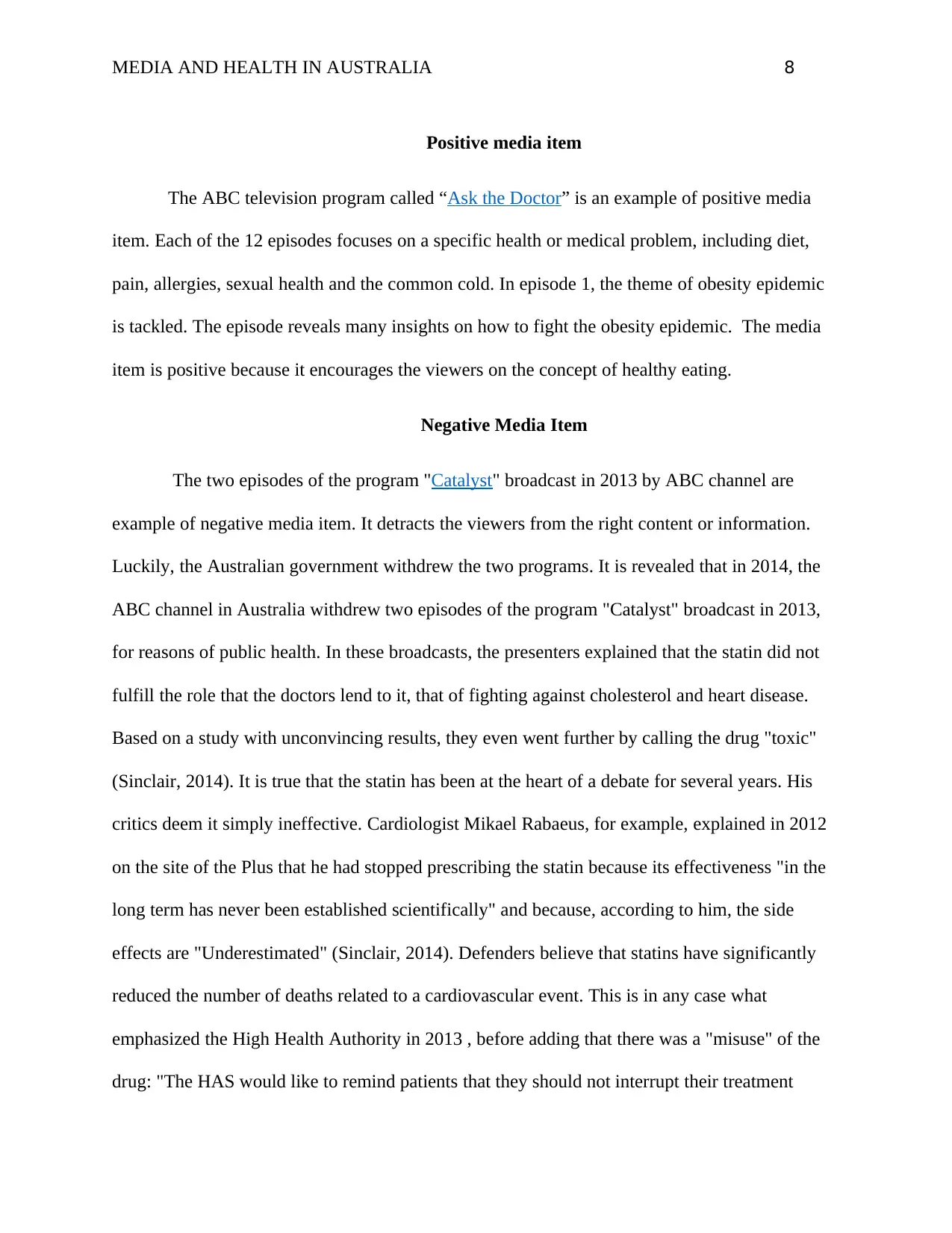
MEDIA AND HEALTH IN AUSTRALIA 8
Positive media item
The ABC television program called “Ask the Doctor” is an example of positive media
item. Each of the 12 episodes focuses on a specific health or medical problem, including diet,
pain, allergies, sexual health and the common cold. In episode 1, the theme of obesity epidemic
is tackled. The episode reveals many insights on how to fight the obesity epidemic. The media
item is positive because it encourages the viewers on the concept of healthy eating.
Negative Media Item
The two episodes of the program "Catalyst" broadcast in 2013 by ABC channel are
example of negative media item. It detracts the viewers from the right content or information.
Luckily, the Australian government withdrew the two programs. It is revealed that in 2014, the
ABC channel in Australia withdrew two episodes of the program "Catalyst" broadcast in 2013,
for reasons of public health. In these broadcasts, the presenters explained that the statin did not
fulfill the role that the doctors lend to it, that of fighting against cholesterol and heart disease.
Based on a study with unconvincing results, they even went further by calling the drug "toxic"
(Sinclair, 2014). It is true that the statin has been at the heart of a debate for several years. His
critics deem it simply ineffective. Cardiologist Mikael Rabaeus, for example, explained in 2012
on the site of the Plus that he had stopped prescribing the statin because its effectiveness "in the
long term has never been established scientifically" and because, according to him, the side
effects are "Underestimated" (Sinclair, 2014). Defenders believe that statins have significantly
reduced the number of deaths related to a cardiovascular event. This is in any case what
emphasized the High Health Authority in 2013 , before adding that there was a "misuse" of the
drug: "The HAS would like to remind patients that they should not interrupt their treatment
Positive media item
The ABC television program called “Ask the Doctor” is an example of positive media
item. Each of the 12 episodes focuses on a specific health or medical problem, including diet,
pain, allergies, sexual health and the common cold. In episode 1, the theme of obesity epidemic
is tackled. The episode reveals many insights on how to fight the obesity epidemic. The media
item is positive because it encourages the viewers on the concept of healthy eating.
Negative Media Item
The two episodes of the program "Catalyst" broadcast in 2013 by ABC channel are
example of negative media item. It detracts the viewers from the right content or information.
Luckily, the Australian government withdrew the two programs. It is revealed that in 2014, the
ABC channel in Australia withdrew two episodes of the program "Catalyst" broadcast in 2013,
for reasons of public health. In these broadcasts, the presenters explained that the statin did not
fulfill the role that the doctors lend to it, that of fighting against cholesterol and heart disease.
Based on a study with unconvincing results, they even went further by calling the drug "toxic"
(Sinclair, 2014). It is true that the statin has been at the heart of a debate for several years. His
critics deem it simply ineffective. Cardiologist Mikael Rabaeus, for example, explained in 2012
on the site of the Plus that he had stopped prescribing the statin because its effectiveness "in the
long term has never been established scientifically" and because, according to him, the side
effects are "Underestimated" (Sinclair, 2014). Defenders believe that statins have significantly
reduced the number of deaths related to a cardiovascular event. This is in any case what
emphasized the High Health Authority in 2013 , before adding that there was a "misuse" of the
drug: "The HAS would like to remind patients that they should not interrupt their treatment
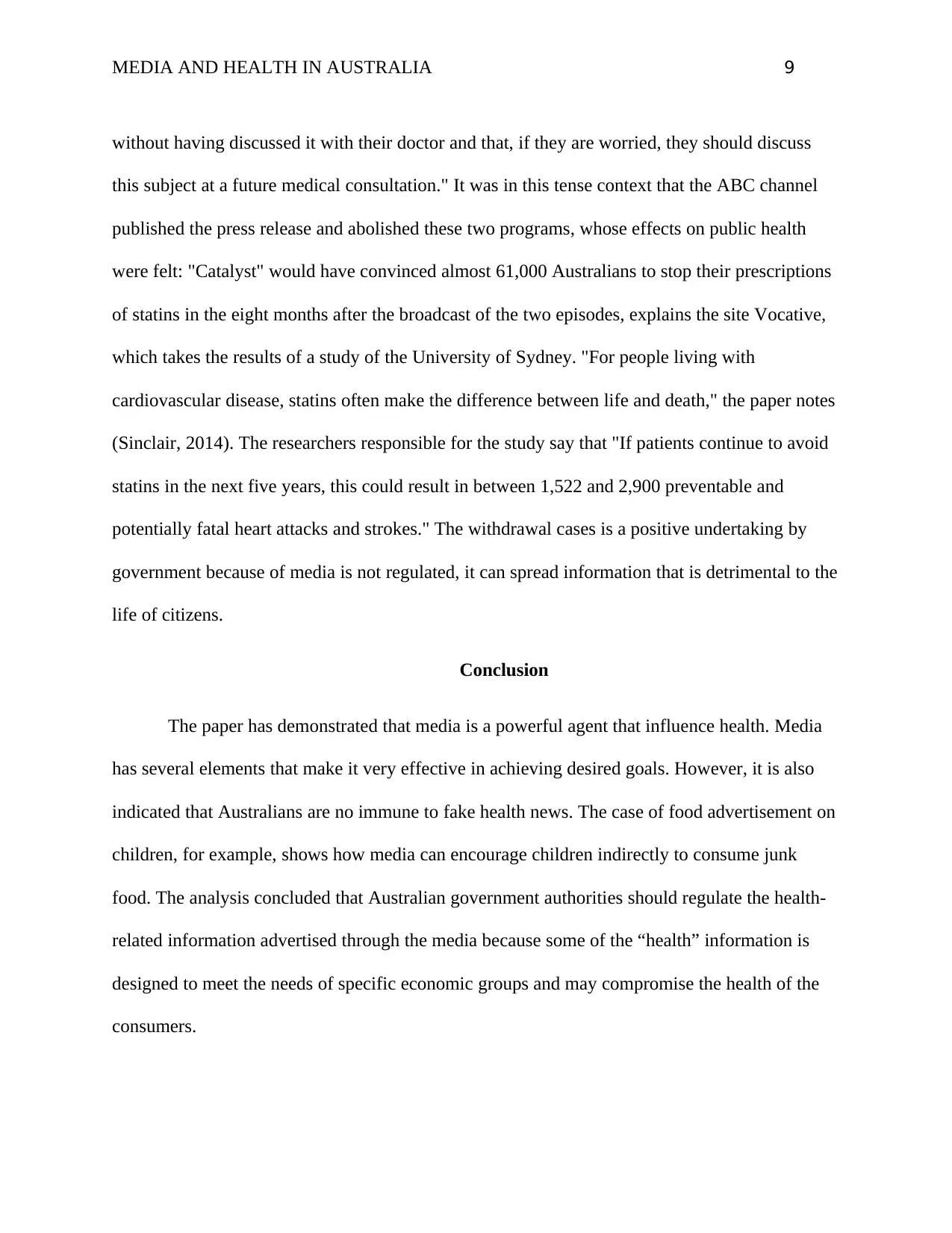
MEDIA AND HEALTH IN AUSTRALIA 9
without having discussed it with their doctor and that, if they are worried, they should discuss
this subject at a future medical consultation." It was in this tense context that the ABC channel
published the press release and abolished these two programs, whose effects on public health
were felt: "Catalyst" would have convinced almost 61,000 Australians to stop their prescriptions
of statins in the eight months after the broadcast of the two episodes, explains the site Vocative,
which takes the results of a study of the University of Sydney. "For people living with
cardiovascular disease, statins often make the difference between life and death," the paper notes
(Sinclair, 2014). The researchers responsible for the study say that "If patients continue to avoid
statins in the next five years, this could result in between 1,522 and 2,900 preventable and
potentially fatal heart attacks and strokes." The withdrawal cases is a positive undertaking by
government because of media is not regulated, it can spread information that is detrimental to the
life of citizens.
Conclusion
The paper has demonstrated that media is a powerful agent that influence health. Media
has several elements that make it very effective in achieving desired goals. However, it is also
indicated that Australians are no immune to fake health news. The case of food advertisement on
children, for example, shows how media can encourage children indirectly to consume junk
food. The analysis concluded that Australian government authorities should regulate the health-
related information advertised through the media because some of the “health” information is
designed to meet the needs of specific economic groups and may compromise the health of the
consumers.
without having discussed it with their doctor and that, if they are worried, they should discuss
this subject at a future medical consultation." It was in this tense context that the ABC channel
published the press release and abolished these two programs, whose effects on public health
were felt: "Catalyst" would have convinced almost 61,000 Australians to stop their prescriptions
of statins in the eight months after the broadcast of the two episodes, explains the site Vocative,
which takes the results of a study of the University of Sydney. "For people living with
cardiovascular disease, statins often make the difference between life and death," the paper notes
(Sinclair, 2014). The researchers responsible for the study say that "If patients continue to avoid
statins in the next five years, this could result in between 1,522 and 2,900 preventable and
potentially fatal heart attacks and strokes." The withdrawal cases is a positive undertaking by
government because of media is not regulated, it can spread information that is detrimental to the
life of citizens.
Conclusion
The paper has demonstrated that media is a powerful agent that influence health. Media
has several elements that make it very effective in achieving desired goals. However, it is also
indicated that Australians are no immune to fake health news. The case of food advertisement on
children, for example, shows how media can encourage children indirectly to consume junk
food. The analysis concluded that Australian government authorities should regulate the health-
related information advertised through the media because some of the “health” information is
designed to meet the needs of specific economic groups and may compromise the health of the
consumers.
⊘ This is a preview!⊘
Do you want full access?
Subscribe today to unlock all pages.

Trusted by 1+ million students worldwide
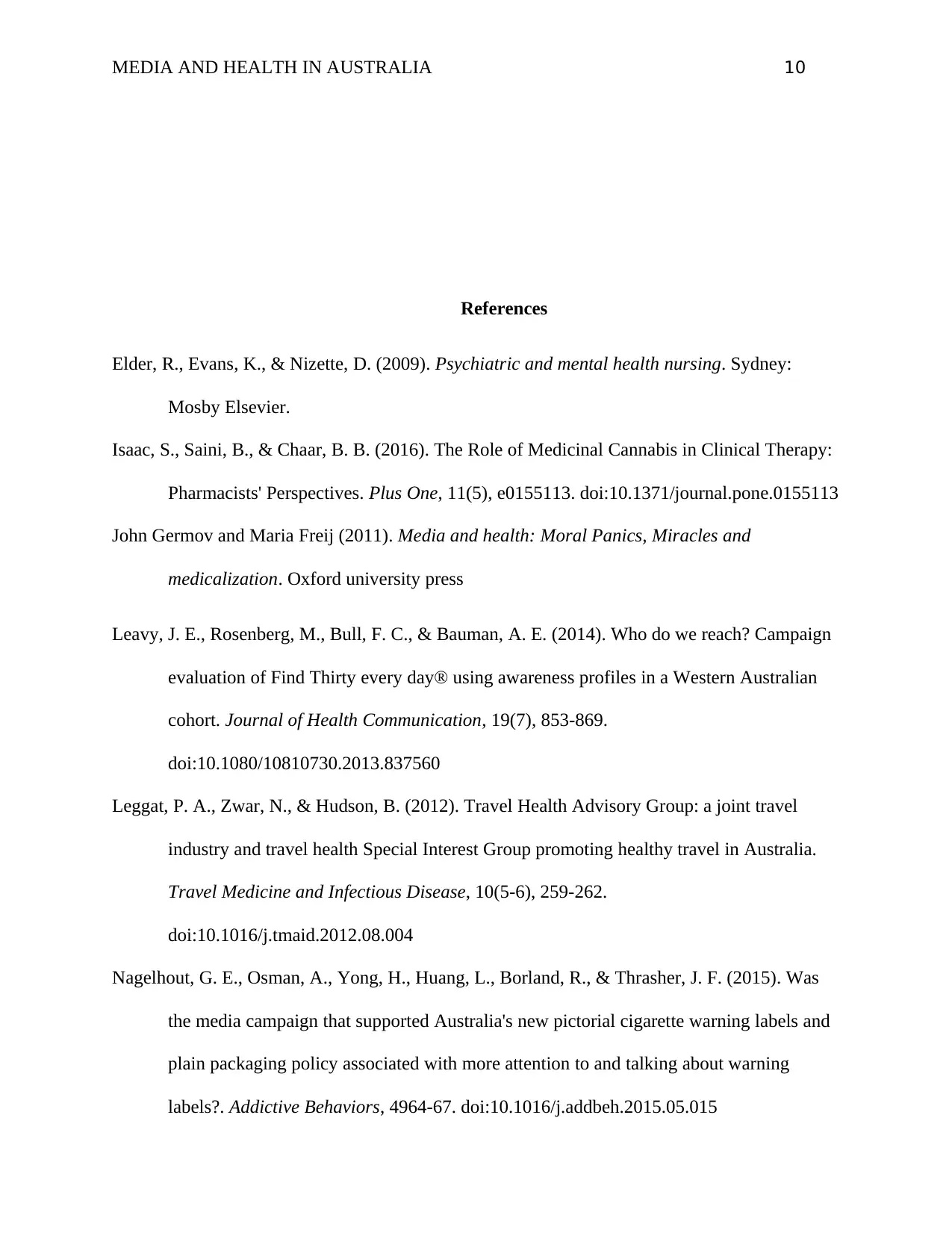
MEDIA AND HEALTH IN AUSTRALIA 10
References
Elder, R., Evans, K., & Nizette, D. (2009). Psychiatric and mental health nursing. Sydney:
Mosby Elsevier.
Isaac, S., Saini, B., & Chaar, B. B. (2016). The Role of Medicinal Cannabis in Clinical Therapy:
Pharmacists' Perspectives. Plus One, 11(5), e0155113. doi:10.1371/journal.pone.0155113
John Germov and Maria Freij (2011). Media and health: Moral Panics, Miracles and
medicalization. Oxford university press
Leavy, J. E., Rosenberg, M., Bull, F. C., & Bauman, A. E. (2014). Who do we reach? Campaign
evaluation of Find Thirty every day® using awareness profiles in a Western Australian
cohort. Journal of Health Communication, 19(7), 853-869.
doi:10.1080/10810730.2013.837560
Leggat, P. A., Zwar, N., & Hudson, B. (2012). Travel Health Advisory Group: a joint travel
industry and travel health Special Interest Group promoting healthy travel in Australia.
Travel Medicine and Infectious Disease, 10(5-6), 259-262.
doi:10.1016/j.tmaid.2012.08.004
Nagelhout, G. E., Osman, A., Yong, H., Huang, L., Borland, R., & Thrasher, J. F. (2015). Was
the media campaign that supported Australia's new pictorial cigarette warning labels and
plain packaging policy associated with more attention to and talking about warning
labels?. Addictive Behaviors, 4964-67. doi:10.1016/j.addbeh.2015.05.015
References
Elder, R., Evans, K., & Nizette, D. (2009). Psychiatric and mental health nursing. Sydney:
Mosby Elsevier.
Isaac, S., Saini, B., & Chaar, B. B. (2016). The Role of Medicinal Cannabis in Clinical Therapy:
Pharmacists' Perspectives. Plus One, 11(5), e0155113. doi:10.1371/journal.pone.0155113
John Germov and Maria Freij (2011). Media and health: Moral Panics, Miracles and
medicalization. Oxford university press
Leavy, J. E., Rosenberg, M., Bull, F. C., & Bauman, A. E. (2014). Who do we reach? Campaign
evaluation of Find Thirty every day® using awareness profiles in a Western Australian
cohort. Journal of Health Communication, 19(7), 853-869.
doi:10.1080/10810730.2013.837560
Leggat, P. A., Zwar, N., & Hudson, B. (2012). Travel Health Advisory Group: a joint travel
industry and travel health Special Interest Group promoting healthy travel in Australia.
Travel Medicine and Infectious Disease, 10(5-6), 259-262.
doi:10.1016/j.tmaid.2012.08.004
Nagelhout, G. E., Osman, A., Yong, H., Huang, L., Borland, R., & Thrasher, J. F. (2015). Was
the media campaign that supported Australia's new pictorial cigarette warning labels and
plain packaging policy associated with more attention to and talking about warning
labels?. Addictive Behaviors, 4964-67. doi:10.1016/j.addbeh.2015.05.015
Paraphrase This Document
Need a fresh take? Get an instant paraphrase of this document with our AI Paraphraser
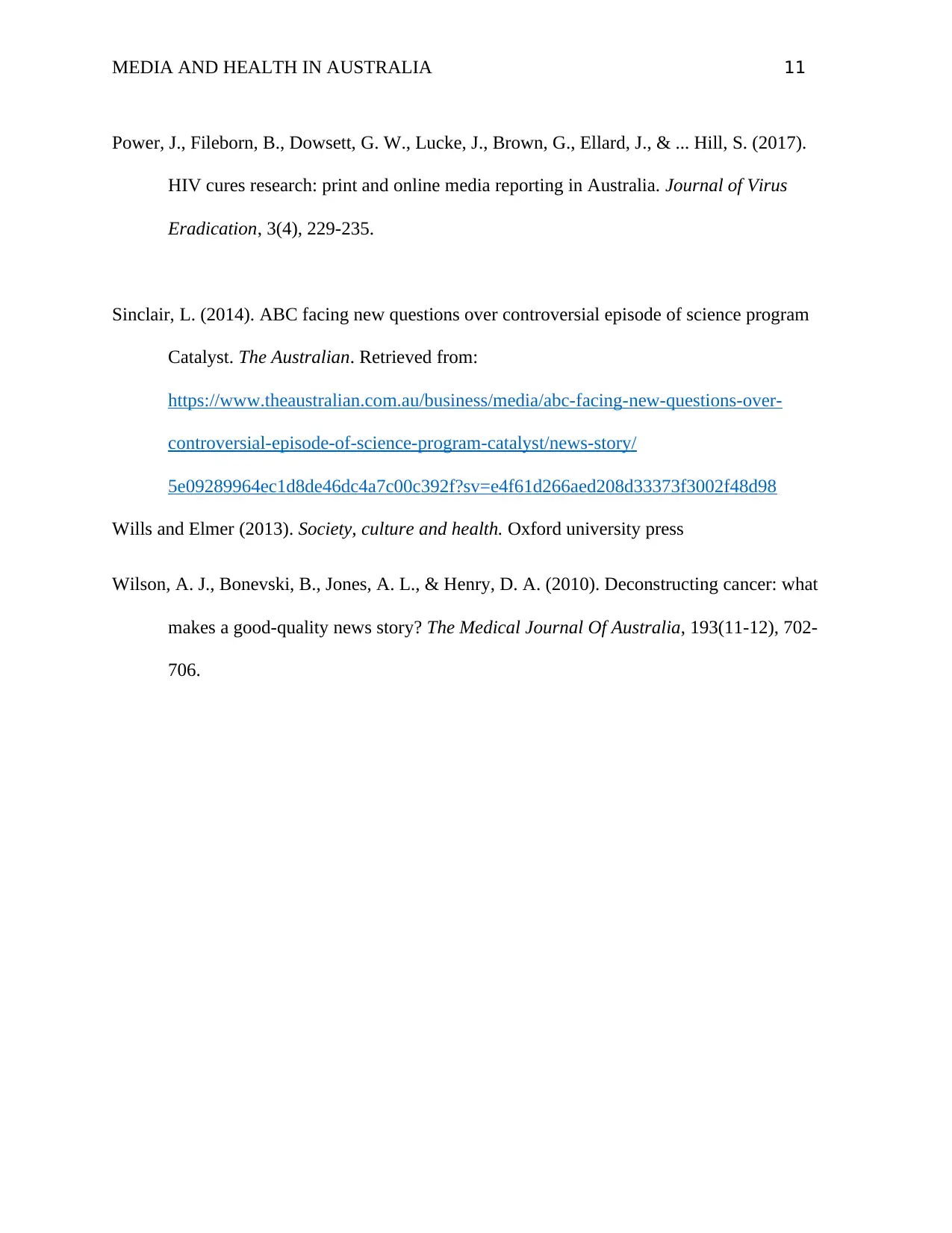
MEDIA AND HEALTH IN AUSTRALIA 11
Power, J., Fileborn, B., Dowsett, G. W., Lucke, J., Brown, G., Ellard, J., & ... Hill, S. (2017).
HIV cures research: print and online media reporting in Australia. Journal of Virus
Eradication, 3(4), 229-235.
Sinclair, L. (2014). ABC facing new questions over controversial episode of science program
Catalyst. The Australian. Retrieved from:
https://www.theaustralian.com.au/business/media/abc-facing-new-questions-over-
controversial-episode-of-science-program-catalyst/news-story/
5e09289964ec1d8de46dc4a7c00c392f?sv=e4f61d266aed208d33373f3002f48d98
Wills and Elmer (2013). Society, culture and health. Oxford university press
Wilson, A. J., Bonevski, B., Jones, A. L., & Henry, D. A. (2010). Deconstructing cancer: what
makes a good-quality news story? The Medical Journal Of Australia, 193(11-12), 702-
706.
Power, J., Fileborn, B., Dowsett, G. W., Lucke, J., Brown, G., Ellard, J., & ... Hill, S. (2017).
HIV cures research: print and online media reporting in Australia. Journal of Virus
Eradication, 3(4), 229-235.
Sinclair, L. (2014). ABC facing new questions over controversial episode of science program
Catalyst. The Australian. Retrieved from:
https://www.theaustralian.com.au/business/media/abc-facing-new-questions-over-
controversial-episode-of-science-program-catalyst/news-story/
5e09289964ec1d8de46dc4a7c00c392f?sv=e4f61d266aed208d33373f3002f48d98
Wills and Elmer (2013). Society, culture and health. Oxford university press
Wilson, A. J., Bonevski, B., Jones, A. L., & Henry, D. A. (2010). Deconstructing cancer: what
makes a good-quality news story? The Medical Journal Of Australia, 193(11-12), 702-
706.
1 out of 11
Your All-in-One AI-Powered Toolkit for Academic Success.
+13062052269
info@desklib.com
Available 24*7 on WhatsApp / Email
![[object Object]](/_next/static/media/star-bottom.7253800d.svg)
Unlock your academic potential
Copyright © 2020–2025 A2Z Services. All Rights Reserved. Developed and managed by ZUCOL.